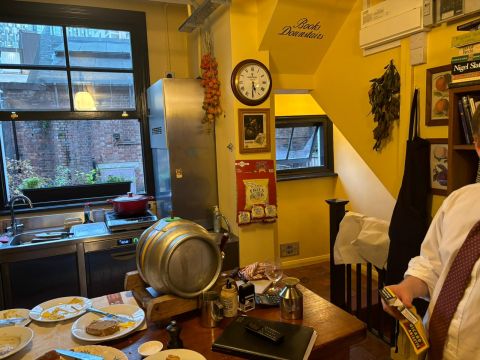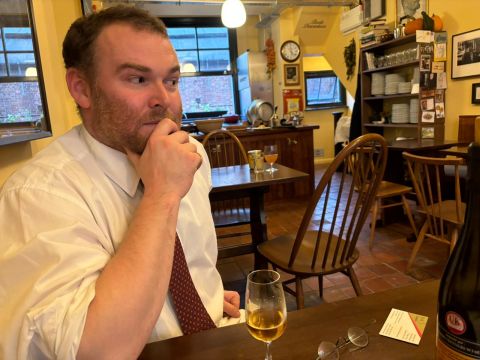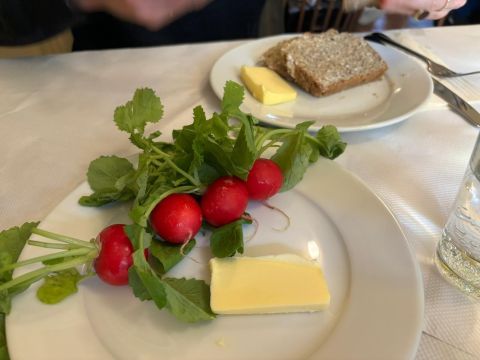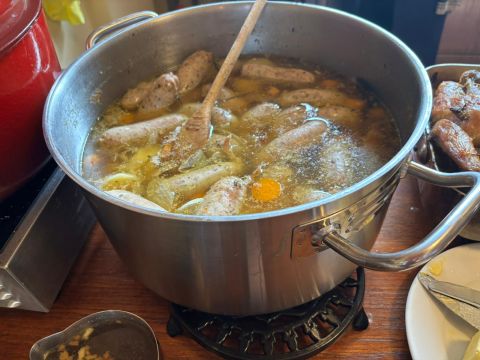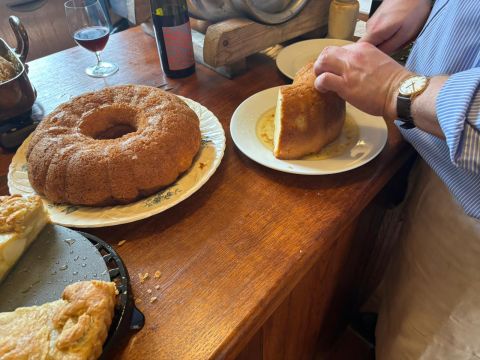There are two ways to enjoy the cooking, hospitality and craic of Ireland. The first is to take a plane, or ferry, to Belfast, Cork, Dublin or Limerick. The second, easier for Londoners and far more recent, is to take the tube to King’s Cross. Walk out of the station, turn left and walk 300 yards until you reach Caledonian Road. Turn left again and walk a further 200 yards. On your right is The Yellow Bittern restaurant, just past the Scottish Stores pub which announces ‘Soup of the day: Guinness!’
Once outside the restaurant, you may have to ring the bell to be let in. But once you are in, one glance is enough to take in the whole of the dining room and the kitchen. The interior is compact and seats 18: there are places for 10 along a banquette down the right-hand side with a few tables of fours and twos opposite. There is an imposing wooden counter on which are Irish cheeses and the two desserts of the day, a keg of beer and the limited space in which the plates are finished.
The kitchen is between the counter and the very useful large window which never seems to be closed as it is the only form of extract for the kitchen. Here are the two induction plates and a domestic oven, a clock advertising Guinness, an advertisement for the defunct cigarette brand Player’s, several packets of Smiths Bacon Fries for sale and a sink. Off on the left is the menu on a chalkboard. To the right is a steep set of stairs that lead down to a bookshop, the wine cellar, the office of the impressively illustrated, hefty Luncheon magazine and the lavatory.
Behind and in front of this counter are the three people responsible for The Yellow Bittern, which takes its name from a poem by Thomas MacDonagh, one of the participants in the Easter Uprising of 1916. Hugh Corcoran (above), born in Belfast, is chef, inspiration and also front of house. His partner Frances Armstrong-Jones takes the bookings and payments and doubles as waitress when not editing the magazine. Oisín Davies, a bookseller who met Corcoran on the eve of Bloomsday in Paris several years ago, is the maker of The Yellow Bittern’s excellent soda bread.
The menu, on Wednesday 23 October, day three of the restaurant’s existence, was modern Irish in its brevity and content. It read: soda bread (£6); radishes and butter (£7); potage Crécy (carrot soup £8); Dublin Coddle (£20); guinea fowl and wood-pigeon pie (£40); roast guinea fowl (£26); green salad (£6); Irish cheeses (£14); and an apple pie and a rum savarin (£9 each). Underneath is written ‘Cash only and no service charge’.
The menu may be simple but our lunch for two was first class. We began, and could have finished, with radishes and Davies’s soda bread, so irresistible and filling was it, before moving on to a stew of Irish sausage and potato (Dublin Coddle – what a great name) as well as roast guinea fowl. What the descriptors of each dish failed to mention was the plethora of slow-cooked vegetables served alongside: cabbage, onions and potatoes with the former and delicious carrots with the latter. The savarin was just as fine, sparing neither cream nor rum.
But what astounded me in my seat at Table 7 was simply that I could so easily have been in a side street in any of the Irish cities I mentioned in my second sentence. I really did feel as though I was in Ireland.
The smiles, and the outfits, of the three individuals definitely contributed to this impression. As did the Welsh quarry tiles on the floor and the open shelf with plates and glasses and cookery books under a poster of Lenin with photos of Brendan Behan and Samuel Beckett close by. There are flowers everywhere, a nod to Pat’s Bar in Belfast, a fact explained to me by Corcoran with whom I sat down a couple of days later.
My first question was how many years had Corcoran, now 35, been thinking about opening The Yellow Bittern. ‘It has been in my head for about 10 years’, he responded with a smile, ‘and I’ve thought seriously about it for a year. I’ve worked as a chef in Paris and the Basque country but it was at Delicatessen in Paris that my ideas started to coalesce. We were offered the space next door [to Delicatessen as an extension to it] but it had only a very limited cooking area, space for only one induction plate in fact. I volunteered there and the venture was very successful, so this [Caledonian Road site] seems quite spacious in fact. We knew we wanted to be in this area and this location seems to work well.
‘The thing is that I like being front of house, talking to my customers and discussing the wines and the dishes they choose. But, like many chefs, I need to be in charge of what is going on in the kitchen as well and this physical layout allows me this possibility. I can come in early and get the meat prepared and start it cooking and then I am here to ensure that everything is plated and sauced properly. For example, there is a very specific Basque method of cutting potatoes for soup which allows more starch to get into the dish. I insist on that.
‘In my opinion cooking here in London is generally of a very high standard but what is missing from more and more restaurants is personality and that is what I am trying to instil here. We are not a huge machine and every day we are open, it is guaranteed that I will be here. And my role now, I believe, is to pare our offer back a little. I think that three main courses may be one too many, that I got carried away at the outset when I saw all those guinea fowl and wood pigeons on offer. But I think that has to be my responsibility in the future, to pare things back and to concentrate even more on quality.’ Keeping it simple could and should arguably be a cri de coeur for every chef but here it is surely taken to the limit.
This new restaurant, apart from being open only for lunch with bookings taken at noon and 2 pm, accepts cash only. I asked him to explain this unusual policy. (There are cash machines nearby.)
‘A small part of this is political, my opposition to those banks and organisations which insist on credit cards and by doing so discriminate against those who do not, or cannot, afford them. Partly, it is also a point of difference, to prove that we can, hopefully, survive without them and the commission they charge. But the main reason is that cash represents the last bastion of privacy, for me at least. I get more pleasure whenever I pay for something in cash rather than with a credit card and I hope that this restaurant is all about giving pleasure. We don’t take reservations online either, just by phone. Or by mail of course and we have already received a number of lovely postcards requesting a reservation. Corcoran pointed to an impressive collection of postcards pinned to the shelves.
The wine list is an amalgam of natural wines and their more established counterparts. In the former category is the elegant black-and-white-labelled 2022 François from Julie Balagny in Beaujolais and a Chénas 2022 from Domaine Thillardon. Italy is represented inter alia by Selvarella 2017 from Marino Colleoni at Podere Santa Maria in Montalcino and bottles of 2016 Sassella Riserva from ARPEPE in Valtellina.
All of this made for a fascinating lunch.
The Yellow Bittern is open for Monday lunch when many restaurants of a similar calibre are closed. There is even a bookshop attached.
The Yellow Bittern 20 Caledonian Road, London N1 9DU; tel: +44 (0)20 3342 2162
Monday to Friday, lunch only. Cash only.
Every Sunday, Nick writes about restaurants. To stay abreast of his reviews, sign up for our weekly newsletter.


